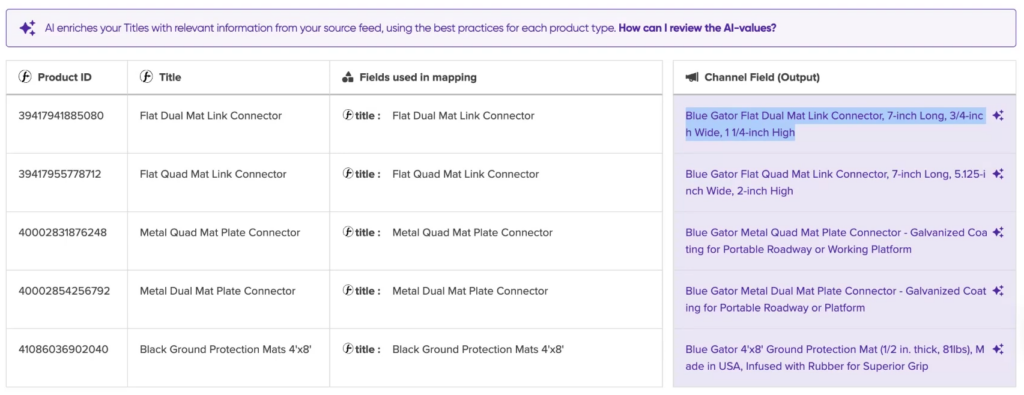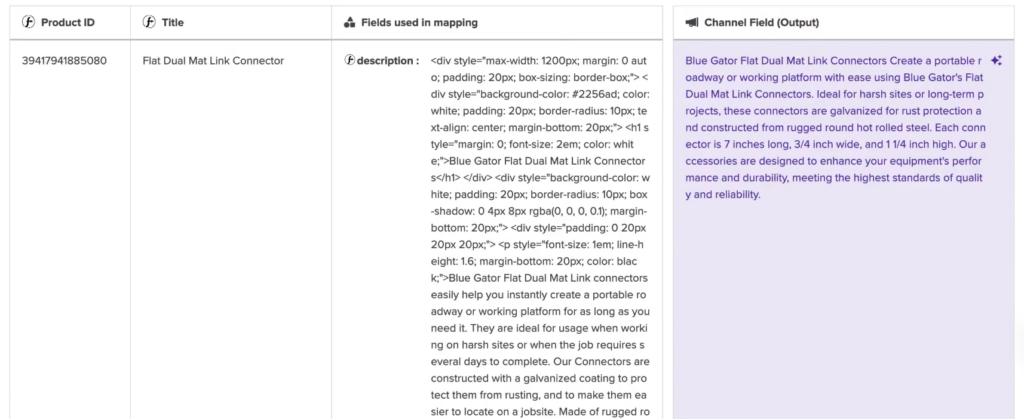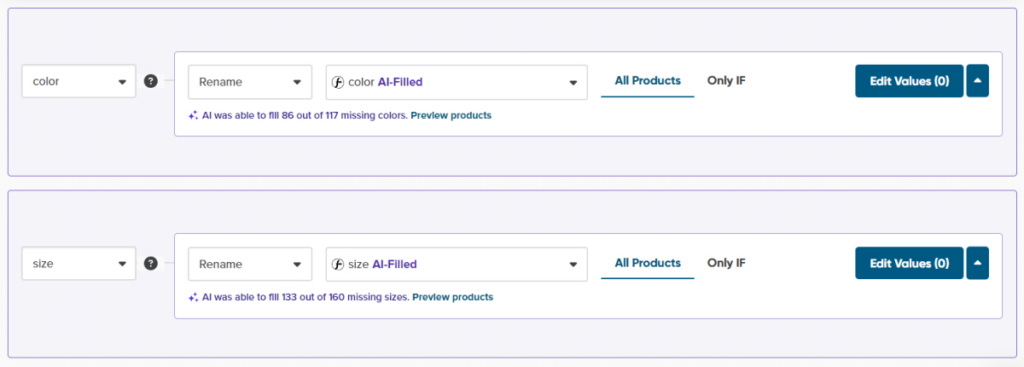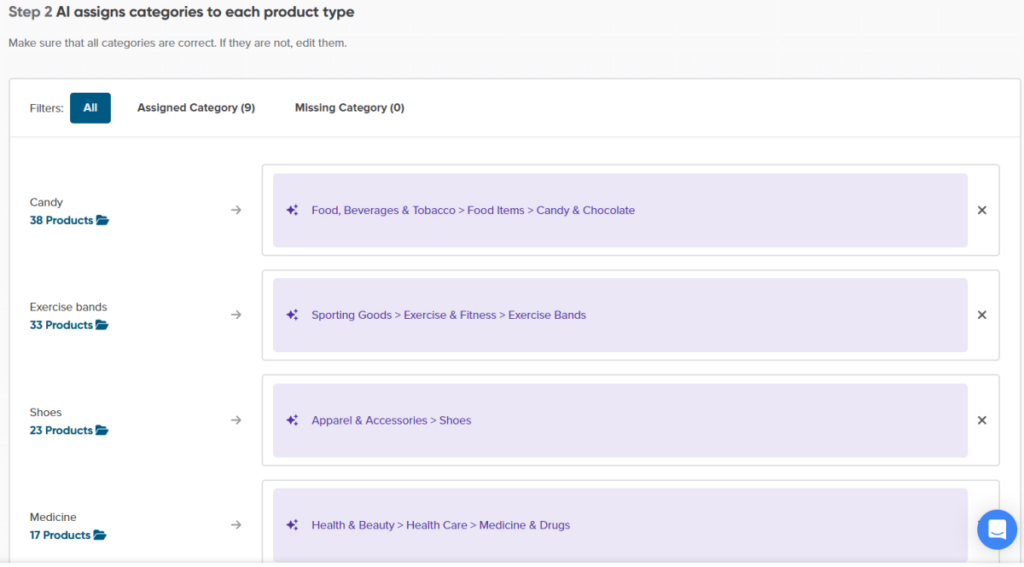AI-Powered Feed Optimization: 6 Ways to Use AI for Product Feed Optimization

Managing product feeds has always been a fundamental yet time-consuming task for PPC professionals and digital marketers. Product feeds contain all the data about the items in your store, which makes your product feed the foundation for your campaigns. The better your data is optimized for the channel you’re advertising on, the better your campaign results will be.
It can, however, be easy to become overwhelmed by the endless amounts of product data and ever-evolving advertising platform requirements.
Enter AI to transform the way marketers approach product feed management.
AI offers opportunities to:
- Streamline workflows
- Automate repetitive tasks
- Perform tasks that can boost campaign performance.
We’ll explore some of the best ways to use AI in your feed optimization strategy, including tools you can use for a single purpose to all-in-one solutions like DataFeedWatch by Cart.com.
The benefits of using AI for product feed optimization
Before we jump into specific AI tools and solutions, it’s important to understand the key advantages of integrating AI into your product feed strategy:
- You’ll save time: You’ll be able to automate repetitive and data-heavy tasks. This will let you focus on activities that need more of your attention like strategy and analysis.
- You can automate tedious tasks: Looking to say goodbye to manual processes? Things like filling in missing data or reformatting product titles can now be handed over to AI.
- Improved accuracy: When working correctly, AI algorithms can analyze data with precision, helping you reduce errors and upholding consistency across your feeds.
With these benefits in mind, let’s explore the exciting ways AI can elevate your feed game.
6 Ways to optimize product feeds with AI
If you’re looking to incorporate AI into your feed management strategy then these methods are for you.
1. ChatGPT
Since gaining popularity, people have been using ChatGPT for a myriad of reasons. And it can also be used for your PPC campaigns.
You can give ChatGPT key attributes such as the names of your products, specific features, and your target audience. Then you can ask ChatGPT to generate compelling and SEO-friendly output that are tailored to platforms you might be using like Google Shopping or Amazon.
Here are some ideas of what you can ask ChatGPT to do: Localize your product feeds
Let’s say you want to start advertising in another location and need to translate your product feed into another language. You can ask ChatGPT to do this for you – however you should still double check it for accuracy and to make sure that words that should stay in their original language (like brands) haven’t been translated.
Create new product titles
You can ask ChatGPT to generate new product titles and optimize them for their specific product category.
Generate ideas for responsive Display Ads
By creating a prompt based on your campaign, you can get suggestions for images, headlines, and descriptions that grab attention and connect with your audience.

Brainstorm relevant keywords
While the data might not be the most up-to-date, you can give a prompt for finding relevant keywords that will bring the right shoppers to your ads.
Give you ideas for A/B testing
Testing is a great way to make improvements to your product feeds. Ask ChatGPT to identify areas you can test, and even give you examples of what you should test specifically.
Pro Tip: Always review and refine AI-generated ad copy to ensure it aligns with your brand voice and campaign strategy.
2. GPT for Sheets
GPT for Sheets integrates AI with Google Sheets and can help you increase your productivity and streamline your data management tasks. It uses OpenAI’s language models, and helps users to automate tasks like:
- Generating test
- Performing data analysis
- Translating content
- Drafting summaries directly within your spreadsheets
You can also get creative on what you ask it to do based on your needs. If you love spreadsheets then it may be a great fit for you.
In regards to feed optimization, you can use GPT for sheets to:
- Rewrite or adjust product titles
- Create new descriptions
- Brainstorm keywords without needing to switch between tools.
- Correct inconsistencies within product feeds
Setting up GPT for Sheets
Once you install GPT for Sheets you’ll find it in the Extensions tab on Google Sheets. Once you enable it, it will become available on the right-hand side of your screen. You should have some free credits to test it out, but then once those are gone you’ll need to pay to use it.


There are a few tutorials to help you get started under the ‘GPT functions’ tab. But for the most part, you’ll put the text you want to reference in one column and then then command you want to give the AI in the column next to it.


3. Keyword Research with AI
Picking the right keywords makes sure your ads appear at the right time to the right audience. There are several AI-driven tools that can help you discover high-performing keywords and long-tail variations. You can use these tools to build targeted campaigns and efficiently monitor keyword trends: According to The State of PPC Survey 2024, the majority of marketers use AI for keyword research at least some of the time. And of those who said they do use AI for keyword research, 59% of them reported to be satisfied with the results.

Ahrefs
Ahrefs is a SEO tool that helps businesses optimize their online presence with features like backlink analysis, keyword research, and site auditing. Known for its vast data, it’s a go-to tool for marketers to boost visibility, track competitors, and drive organic traffic.
Some of the AI features include keyword suggestions, search intent, and a content helper.
Semrush
Semrush is a digital marketing tool that simplifies SEO, PPC, content marketing, and competitor analysis. With features like keyword tracking, site audits, and strategic insights, it helps businesses optimize campaigns and improve online performance.
Semrush has introduced AI features like a keyword strategy builder and a keyword magic tool that gives you AI-powered insights from your website.
AnswerThePublic
AnswerThePublic is a tool that helps businesses and marketers understand what their audience is searching for online. It uses search engine autocomplete data to generate related queries, making it useful for content creation and SEO by highlighting user intent and improving engagement.
4. Google Product Studio
Product Studio is a free tool from Google and includes a group of AI-powered features. It was created to help create and enhance high-quality product images and videos with no extra effort.
With just a few clicks, you can:
- Generate scenes
- Improve image resolution
- Edit backgrounds
- Create product videos.
These visuals can then boost customer engagement and elevate your marketing across all channels. According to Google, “80% of surveyed users already have been more efficient or expect to be more efficient by using Product Studio.”
Google Product Studio is available for Merchant Center Next users and through the Google and YouTube app for Shopify users.
5. Use Google Ads scripts
AI-powered Google Ads scripts use artificial intelligence to automate and optimize ad campaigns.
They handle tasks like:
- Bid adjustments
- Keyword management
- Pausing underperforming ads
- Performance reporting
- Analyzing trends
- Providing predictive insights
Created by marketers or third parties, these scripts can be custom-built or pre-made and are integrated into the Google Ads platform, often enhanced with external AI tools. They improve efficiency, reduce costs, and minimize errors, making them extremely useful for scaling and optimizing campaigns.
One of the most prominent creators of Google Ads scripts is Mike Rhodes who has a whole library of scripts and resources. You can follow Mike Rhodes on LinkedIn here.
There are also tools like FeedGen, an open-source tool powered by Google Cloud’s Large Language Models. It can optimize the structure of your product feed, making it compliant with formats required by advertising platforms.
6. Generative ad copy tools
Tools like Jasper and Copy.ai are useful for creating polished text for your campaigns. These AI-powered platforms can produce tailored content in seconds, helping craft compelling product descriptions or attention-grabbing ad headlines.
On whether ChatGPT or Jasper is better, Jasper says, “While ChatGPT may provide AI-generated content, it lacks the comprehensive analytics capabilities that Jasper offers.” So if you’re looking for a solution that is more geared towards marketing, a paid tool might be more beneficial for you.
All-in-one solution: AI powered-feed optimization with DataFeedWatch by Cart.com
Up until now, using AI in feed management required advertisers to juggle multiple tools, like the options we looked at above. For example, if you created an ad copy with ChatGPT you would then need to manually transfer it to a spreadsheet. While the tools mentioned earlier are helpful, aside from Google’s features, none directly integrate with ad campaigns.
That has changed with DataFeedWatch by Cart.com introducing native AI-powered feed optimization. You can now optimize your product data automatically
DataFeedWatch was designed to automate feed optimization, saving time and driving business growth. With 12 years of experience and industry best practices, it now empowers PPC professionals with AI-driven solutions to take their campaigns to the next level.
Here’s how you can start using it:
AI-generated titles and descriptions
Product titles and descriptions are just as important as images when it comes to the success of your ads. They give shoppers a quick summary of your product and help the advertising platform understand when to show your ads. The keywords you use, along with the order you place them in, play a big role in how well your ads perform. For instance, crafting a title for clothing differs from creating one for furniture.


Creating effective titles takes time and industry know-how. But instead of manually researching the best title structure for each product, you can generate optimized titles and descriptions automatically with just one click by using DataFeedWatch AI.
We use your source data (like your product feed or connected store), to generate new titles and descriptions that align with industry standards. This helps your products show up in more relevant searches, saving you time and effort.
Take it even further with A/B testing
You can even A/B test these AI-generated titles against your current ones to see which performs better. Testing is a proven way to maximize your campaign results without extra effort.
One example of this is when agency Socium increased their client’s ROAS by 25% and lowered their CPC by 10% through testing whether brand names should go at the beginning or the end of product titles.
Fill in missing attributes
You might have the data you need hidden somewhere in your product feed. DataFeedWatch AI will extract color and size fields from your feed and assign them to the right place.

Product feeds are rarely ready to upload to the channel you’re advertising on “as is”. Key data like size and color are often placed in the wrong fields, or hiding somewhere in your feed. Fixing these issues can be time-consuming, especially for larger catalogs. And missing these attributes can result in product errors for certain categories like apparel.
Now, with DataFeedWatch’s AI, advertisers can automatically fill in missing size and color data with the click of a button. The AI will scan your source feed to find the right information and place it in the correct fields.
By fixing errors and filling in missing data in bulk, you can quickly enable more products to appear, increasing your chances of driving more conversions.
Google Product Categories
Did you know Google’s taxonomy includes over 6,000 product categories? That makes it a challenge to match your products to the right one, which is an important step in improving your campaign performance. Accurate product matching helps Google display your products for the right searches so that shoppers looking for your specific product can find them.

With DataFeedWatch, this entire process is now automated. Plus, you can still review and adjust the selected product categories whenever needed.
Bonus Tip: Follow Google’s Ads AI Essentials checklist for your campaigns
Optimized product feeds go hand in hand with optimized campaigns. Over the years, Google has been investing heavily in its AI-powered features. Google has created a Google Ads AI Essentials list that you can even use to apply the changes right in your account. It includes AI-powered features that can help you run your ad campaigns.
Here’ an overview of everything they suggest:
Use Google Tag
You can use Google Tag for tagging across your whole site to get the most important data for your campaigns.
Set up enhanced conversions
Your first-party data will be used to measure your online conversions more accurately.
Assign goal-based values for Smart Bidding
You may have different goals for your campaigns, like gaining more revenue.
Google Analytics
Using Google Analytics will help you
Customer Match
Customer Match is a feature that lets you use your online and offline to interact with your customers again across all Google surfaces.Google AI will use the data you provide to deliver personalized ads to your customers.
AI-powered creative tools
Google has created AI-powered creative tools to help advertisers to generate quality creatives at scale.
AI-powered Search campaigns
This will let you target relevant shoppers from all stages of the buyer’s journey, regardless of how they’re searching.
Use Performance Max campaigns
Google’s AI-powered campaign is goal based, and can help you convert customers across all Google channels.
Use Demand Gen campaigns
Demand Gen campaigns use YouTube and other visual surfaces to create demand and convert when shoppers aren’t searching for your products.
Video campaigns
You can connect your audience across YouTube for AI-powered video campaigns.
How to use AI wisely for feed optimization
AI is a powerful tool, but it works best when paired with human expertise. Here’s some guidelines to follow to use AI effectively:
- Combine AI with your human insight
AI can automate tasks and provide suggestions, but only you have a first-hand understanding of your brand and audience. Keeping this in the forefront makes sure any actions you take are aligned with your goals.
- Always test and keep optimizing
Experiment with AI-generated content using A/B testing to identify the best-performing variations. Testing is key to improving both your campaigns and your understanding of AI’s capabilities.
- Maintain control
Most AI-enabled platforms allow customization. Don’t hesitate to adjust AI-generated outputs, ensuring they meet your specific campaign needs.
Is AI the future of PPC?
AI isn’t just a buzzword anymore, rather it’s becoming a necessity for marketers looking to stay competitive in a rapidly evolving PPC world. With tools like ChatGPT, Google Product Studio, and DataFeedWatch by Cart.com, digital marketers can transform their strategies, improve efficiency, and drive better results.



